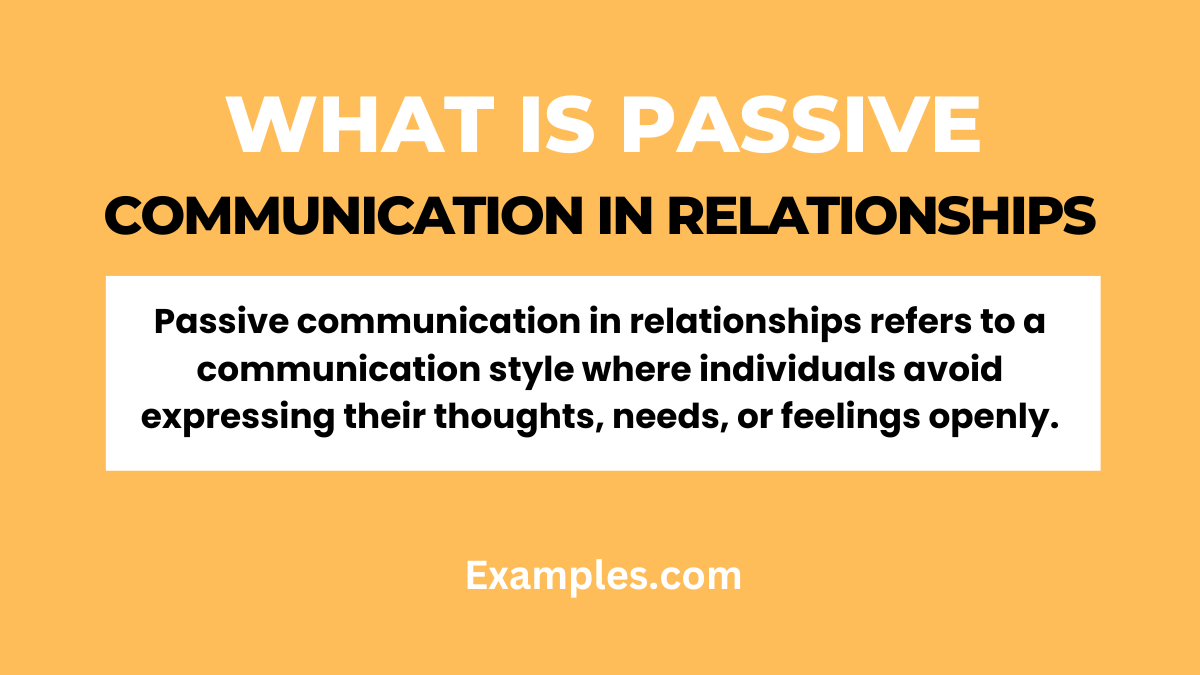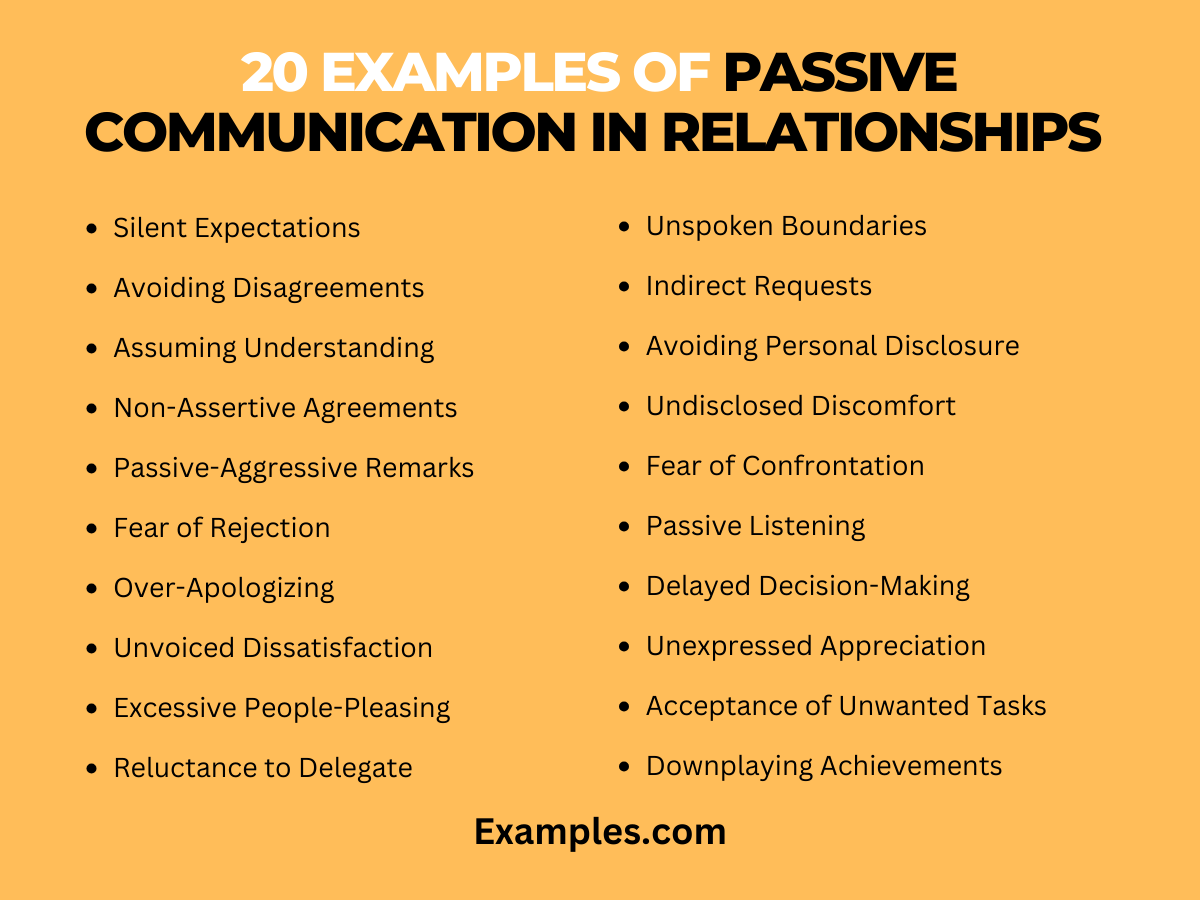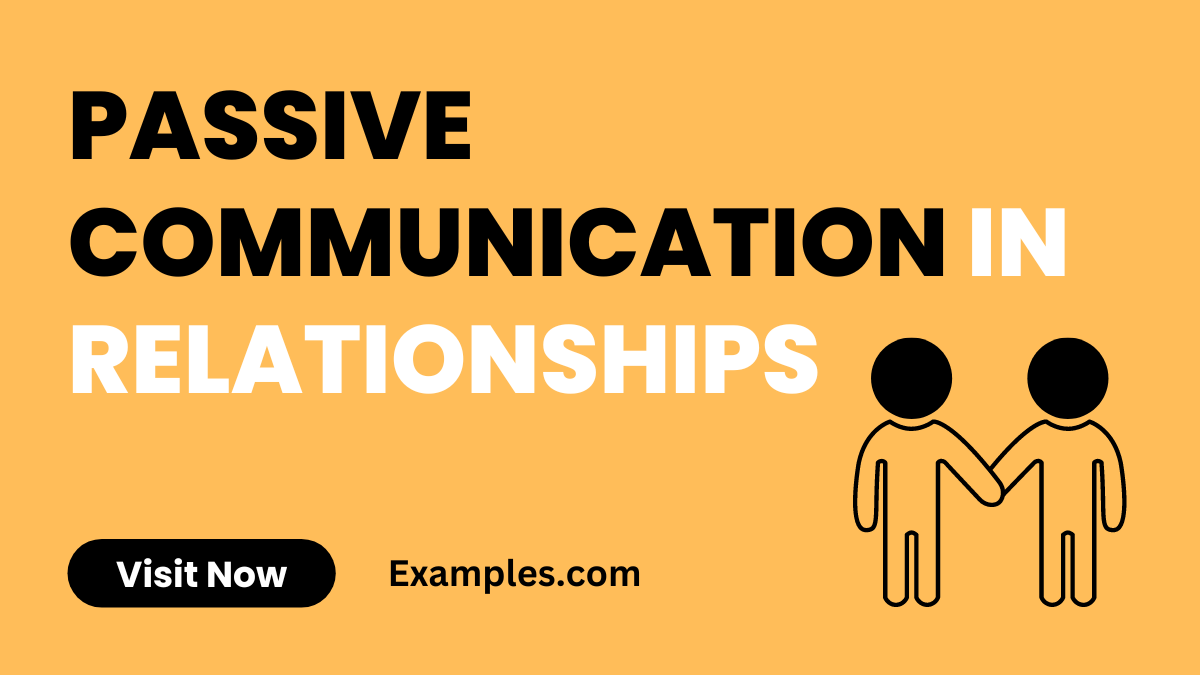Passive Communication in Relationships
Embark on a transformative journey through our comprehensive guide on Passive Communication in Relationships. Uncover the subtle intricacies, pitfalls, and remedies for fostering healthier connections. With relatable Communication Examples, this guide provides practical insights and actionable tips to navigate passive behaviours effectively, empowering you to cultivate stronger, more assertive, and fulfilling relationships. Dive into the dynamics of passive communication, understanding its impact, and embracing transformative strategies for building robust connections.
Passive Communication in Relationships? – Definition
 Passive communication in relationships refers to a communication style where individuals avoid expressing their thoughts, needs, or feelings openly. This often leads to unmet expectations, misunderstandings, and a lack of clarity in interpersonal dynamics. In simple terms, passive communicators tend to downplay themselves, yielding to others excessively, which can hinder the development of healthy relationships. Understanding the definition of passive communication in relationships is crucial for recognizing and addressing this behaviour to promote more open and effective communication.
Passive communication in relationships refers to a communication style where individuals avoid expressing their thoughts, needs, or feelings openly. This often leads to unmet expectations, misunderstandings, and a lack of clarity in interpersonal dynamics. In simple terms, passive communicators tend to downplay themselves, yielding to others excessively, which can hinder the development of healthy relationships. Understanding the definition of passive communication in relationships is crucial for recognizing and addressing this behaviour to promote more open and effective communication.
20 Examples of Passive Communication in Relationships
Unlock the nuances of passive communication in relationships with these compelling examples. Delve into relatable scenarios that shed light on the benefits and challenges of passive communication, offering valuable insights for fostering healthier connections.

- Silent Expectations: Hoping your partner understands unexpressed needs without clear articulation.
- Avoiding Disagreements: Sidestepping discussions to prevent potential conflicts, leading to unresolved issues.
- Assuming Understanding: Expecting others to comprehend your feelings without verbalizing them.
- Non-Assertive Agreements: Agreeing reluctantly without expressing personal opinions or desires.
- Passive-Aggressive Remarks: Using indirect sarcasm or subtle jabs instead of addressing concerns openly.
- Fear of Rejection: Avoiding expressing feelings to prevent potential rejection or criticism.
- Over-Apologizing: Apologizing excessively, even when not at fault, to maintain harmony.
- Unvoiced Dissatisfaction: Holding back dissatisfaction, contributing to a growing sense of resentment.
- Excessive People-Pleasing: Prioritizing others’ preferences over personal needs to seek approval.
- Reluctance to Delegate: Hesitating to delegate tasks, fearing negative reactions or incompetence.
- Unspoken Boundaries: Failing to communicate personal boundaries, leading to potential misunderstandings.
- Indirect Requests: Hinting at needs instead of directly expressing them, causing confusion.
- Avoiding Personal Disclosure: Shying away from sharing personal information to maintain privacy.
- Undisclosed Discomfort: Concealing discomfort or displeasure, hindering emotional transparency.
- Fear of Confrontation: Stepping back from necessary confrontations to avoid discomfort.
- Passive Listening: Pretending to listen actively while internal thoughts remain unexpressed.
- Delayed Decision-Making: Procrastinating decisions to avoid taking responsibility or making choices.
- Unexpressed Appreciation: Failing to communicate appreciation for fear of vulnerability.
- Acceptance of Unwanted Tasks: Taking on undesired tasks without expressing preferences, leading to dissatisfaction.
- Downplaying Achievements: Minimizing personal achievements to avoid appearing boastful or seeking validation.
Passive Communication in Relationships at Workplace
Explore the dynamics of passive communication within the workplace setting. Uncover the intricacies of subtle behaviours and their impact on professional relationships. This guide provides insights into fostering assertiveness, effective collaboration, and open communication in a work environment.
- Over-Reliance on Email: In critical situations, a passive communicator might avoid face-to-face discussions, relying solely on email to communicate concerns.
- Avoiding Team Contributions: A passive individual may withhold valuable insights during team discussions to evade potential disagreement.
- Unexpressed Professional Goals: Passive employees may refrain from articulating career aspirations, hindering professional growth.
- Failure to Set Boundaries: A passive approach might lead to difficulties in setting clear boundaries with colleagues, impacting work-life balance.
- Reluctance to Seek Feedback: Passive communicators might hesitate to seek constructive feedback, missing opportunities for personal development.
- Indirect Critique of Ideas: Rather than openly critiquing ideas, passive individuals might indirectly express disapproval through subtle nonverbal cues.
- Apologizing Excessively: Over-apologizing for minor mistakes can be a sign of passive communication, reflecting a fear of perceived inadequacy.
- Avoiding Conflict Resolution: Passive individuals may steer clear of addressing conflicts directly, allowing issues to persist.
- Downplaying Achievements: A passive approach might lead someone to downplay their accomplishments, minimizing personal contributions.
- Fear of Delegating Tasks: A passive leader may hesitate to delegate tasks, fearing potential resistance or conflict within the team.
What Are 4 Characteristics of a Passive Communicator?
Passive communication in relationships is marked by distinct characteristics that impact interactions. Recognizing these traits is crucial for fostering healthier connections:
- Avoidance of Conflict: Passive communicators tend to avoid conflicts at any cost, often suppressing their true thoughts and feelings to maintain harmony.
- Difficulty Expressing Needs: Individuals with passive communication tendencies find it challenging to express their needs openly, leading to unmet expectations.
- Over-Apologizing: Apologizing excessively, even for minor issues, is a common trait of passive communicators who fear judgment or rejection.
- Reluctance to Share Opinions: Passive individuals may hesitate to voice their opinions, contributing to a lack of diversity in discussions and decision-making.
How to Spot the Passive Communicator and What to Do About It
Spotting passive communication in relationships requires keen observation and understanding. Here’s how to identify and address passive communication effectively:
- Recognize Subtle Cues: Passive communicators often use subtle body language or vague expressions. Pay attention to nonverbal cues indicating discomfort or unspoken thoughts.
- Listen Actively: Actively listening to what is not said is crucial. Passive individuals might withhold information, so encouraging open dialogue is essential.
- Encourage Open Communication: Create a safe space for sharing thoughts and feelings. Passive communicators may open up in an environment that fosters trust and understanding.
- Provide Constructive Feedback: Offer feedback in a constructive manner. Passive individuals may fear criticism, so framing feedback positively encourages more openness.
- Use Assertive Language: Model assertive communication by expressing yourself clearly and respectfully. This sets a positive example for passive individuals to follow.
- Promote Empowerment: Encourage passive communicators to recognize their value in relationships. Empower them to express themselves and assert their needs confidently.
- Offer Support: Understand that shifting communication styles takes time. Be supportive, patient, and offer guidance as individuals work towards more assertive interactions.
In conclusion, Passive Communication in relationships transcends words, fostering understanding and connection. By embracing subtle cues, nonverbal gestures, and empathetic silence, individuals can navigate emotional nuances effectively. This guide has illuminated the art of passive communication, providing a roadmap for building stronger, more authentic relationships through the power of unspoken language.



